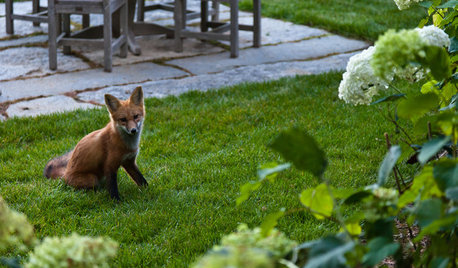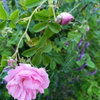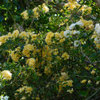Horse manure questions
saldut
11 years ago
Featured Answer
Sort by:Oldest
Comments (60)
jeannie2009
11 years agopfzimmerman
11 years agoRelated Discussions
Soil impaction, horse manure, chicken manure
Comments (5)Many garden centers sell inexpensive pH test kits. They're fun, and simplify all that pH stuff. Your manure and organic matter (and the life forms they support) will nudge it toward neutral over time, and it can be interesting to watch. Fall is the best time for serious liming. Permanent pathways provide habitat for earthworms, ground beetles, etc, and give you some access regardless of the weather. For temporary access to some areas, you also can lay boards on the ground and stand on the boards. If you planned to use your wheat as a cover crop, you'll need to take it down 2-3 weeks before you need the space, or you can pull it up and let it dry into mulch, or compost it. In mild winter climates, actively growing wheat does not go down without a little bit of a fight. Back to the permanent pathways. You can sow them with legumes and well-behaved grasses, and mow them to make mulch for the beds or rows next to them. It's a cool system. Picture it -- next year, a ribbon of crimson clover laced with blue bachelor buttons leads you to your beautiful [fill in blank] and you feel so happy! Here is a link that might be useful: my website...See MoreHorse manure question from a noob
Comments (9)How much material is there? Depending on your air temps 18 inches is a bit shallow to get the pile to heat up to any degree, it might, but 36-48 inches is better. In a no wind situation, the greatest heat loss is through the top so a bit thicker is better. It has to be moist, if it's too dry it takes longer to break down, if its too wet it won't get the air it needs, sorry, pretty wishy washy answer. Tarp may be good idea once the pile is moist but don't seal it in Zip Lock bags or anything. As far as lasagna beds, never built one so I am not the guy to take advice from on that. But personally, I would rather not grow vegetables in uncomposted animal manure. Sorry, I should say I would rather not eat vegetables grown in uncomposted animal manure. Now I bet some of the stuff in the grocery store is grown in that manner, I'll just pretend I don't know that. Given two months and some management (monitor moisture, turn once or twice) I'm guessing that pile will decompose nicely as long as your weather allows it. (mine won't, too cold) One more question, it looks like it is really well mixed, did the farmer guy mix it somehow before he brought it? Be kinda cool if I could drop by to look at it, I am considering "borrowing" a truck load of horse crap to mix with some leaves and shredded wheat straw to try in the tumblers as an experiment. Lloyd...See MoreCompost and Lime question
Comments (4)Lime is not needed in any compost pile. The idea that it might be needed comes from old mythical folklore that because Oak leaves are acidic (my tests years ago told me 3.7 pH) but since Maple leaves (pH 3.2), Beech leaves(pH 3.3), Chestnut leaves (pH 3.2) are just as acidic why would lime not be needed with those? The manure you have may have had lime added to aid in control of flies. For those of us that can remember the old dug outhouses some may remember that lime was sprinkled on the "stuff" down there to help control flies....See Morehorse manure, cow manure, lasagna garden...
Comments (4)When I did, in my ignorance, add animal manures to the garden beds without first composting those manures, I did see an increase in "weeds" and it made no difference if it was manure from dairy cows, horses, pigs, goats, sheep, llamas or alpacas, unless it was dehydrated manure. It seems the heat used to dry that manure was enough to kill any "weed" seeds. Since the easiest method to keep these "weed" seeds out of the garden is to compost the manure first it simply makes sense to do that, along with all the other very good reasons to compost manure before applying it to your garden soil....See Morestrawchicago z5
11 years agofloridarosez9 Morgan
11 years agohenry_kuska
11 years agosaldut
11 years agojerijen
11 years agosubk3
11 years agostrawchicago z5
11 years agosaldut
11 years agosherryocala
11 years agoKippy
11 years agofloridarosez9 Morgan
11 years agostrawchicago z5
11 years agoKippy
11 years agostrawchicago z5
11 years agoKippy
11 years agomalcolm_manners
11 years agosaldut
11 years agomalcolm_manners
11 years agoKippy
11 years agosherryocala
11 years agosaldut
11 years agosherryocala
11 years agocatspa_NoCA_Z9_Sunset14
11 years agoharmonyp
11 years agofloridarosez9 Morgan
11 years agosaldut
11 years agofloridarosez9 Morgan
11 years agosubk3
11 years agosherryocala
11 years agoannesfbay
11 years agosaldut
11 years agoPonchos.Dad
10 years agofloridarosez9 Morgan
10 years agoporkpal zone 9 Tx
10 years agorosefolly
10 years agoKippy
10 years agoUser
10 years agoporkpal zone 9 Tx
10 years agosubk3
10 years agomichaelg
10 years agoUser
10 years agosubk3
10 years agoporkpal zone 9 Tx
10 years agoUser
10 years agosaldut
10 years agoUser
10 years agosaldut
10 years ago
Related Stories

GARDENING GUIDESThe Poop Scoop: Enrich Your Soil With Good Old Manure
Get over the ick factor already — this natural super-ingredient for soil has so many benefits, you'll wonder why you ever went chemical
Full Story
DOORS5 Questions to Ask Before Installing a Barn Door
Find out whether that barn door you love is the right solution for your space
Full Story
SELLING YOUR HOUSE15 Questions to Ask When Interviewing a Real Estate Agent
Here’s what you should find out before selecting an agent to sell your home
Full Story
CURB APPEAL7 Questions to Help You Pick the Right Front-Yard Fence
Get over the hurdle of choosing a fence design by considering your needs, your home’s architecture and more
Full Story
KITCHEN DESIGNKitchen of the Week: Casual Equestrian Feel on a Horse Farm
Red cabinetry, salvaged barn decor and a window for feeding treats to horses combine in a lively, comfortable family kitchen
Full Story
FUN HOUZZThe Cutest Darn Animals on Houzz
You might end up admiring these horses, goats, llamas and more until the cows come home
Full Story
FARMHOUSESHouzz Tour: Rugged Charm for a Washington Farmhouse
Horses sidle close to this rustic home and guest cottage, which keep the pastoral pace with generous wood and simple forms
Full Story
TRANSITIONAL HOMESHouzz Tour: A Happy-Trails Home on a California Field
Horse-loving homeowners look to barns and equestrian references for their light and bright new build
Full Story
HOUZZ TOURSHouzz Tour: A Ranch House Is Reborn in a Los Angeles Canyon
Can you get back to nature in the heart of an urban mecca? This family — and their horses, dogs and chickens — did just that
Full Story
FUN HOUZZHouzz Quiz: What's Your Decorating Style?
Answer these 9 questions to find out what decorating style suits you best
Full Story









floridarosez9 Morgan